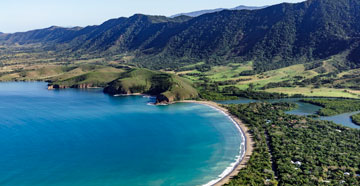A traditional way of life continues on the island of Tiga, where residents enjoy peaceful times. The few tourists who visit get a taste for the simple pleasures shared by the inhabitants: communal meals, bingo and catching shellfish on the reef flats...
Situated around thirty kilometres north of Maré, the island of Tiga (Tokanod in the Drehu language) is the smallest and most discreet of the Loyalty Islands, with its ten square kilometres and highest point at just 92m. Viewed from the sea, the island appears in the shape of a dome raised over the waves of the Coral Sea.
A tribute to the traditional way of life
Populated by a single tribe who live in the north-west, the island has neither a restaurant nor a hotel, but a charming shack in place of a grocery store. It is possible to find dried staple goods. For everything else, Tiga depends entirely on the outside world for supplies, and is served regularly by a catamaran and air links.
Few ‘hard’ buildings can be found on Tiga. Only the grocery store, post office and temple can be considered as such. The rest of the village is mainly made up of traditional huts and modest houses covered with corrugated metal. Vehicles are even rarer to find. It is much more likely that you’ll bump into pedestrians than cars on the island's one tarmac road.
On the menu: yams, sweet potatoes and shellfish!
To ensure their survival, the inhabitants rely mainly on themselves. While the shallot, previously known as Tiga’s green gold, has sadly disappeared from gardens, yams and sweet potatoes continue to be cultivated in fields situated on the upper plateau. To make their meals more exciting, the island’s residents can also count on fresh seafood: shellfish, spider crabs and fish are abundant in the waters surrounding the island. In fact, Tiga does not have a lagoon, but rather beautiful reef flats covered with canyons stretching for hundreds of metres before falling into the great deep...
The island also has copra (a dried form of the whitish, translucent liquid of the coconut) and an untapped phosphate reserve. These resources are, however, far too little to provide permanent work for the young people who, when they finish primary school, generally leave their birthplace for Lifou or Nouméa.
- CEMAID Lifou
- Opening hours: Monday to Thurday : 7h30 - 11h30 and 12h30 - 16h30, Friday : 7h30 - 11h30 and 12h30 - 15h30
- Telephone: + 687 45 00 32
- Email: cemaid@cyerdidact.mls

The island's curved shape has given rise to a legend, passed down orally: a rat, chased out by the inhabitants of the island of Lifou, took refuge on a rock named Taetawanod. It cried so much that a turtle agreed to carry it on its shell to Maré. However, the turtle decided to play a dirty trick on his companion, and stopped his journey halfway. And that's how Tiga was born!







